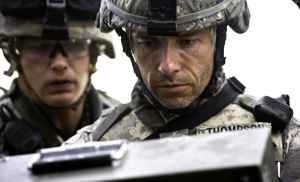- MENU
- HOME
- SEARCH
- WORLD
- MAIN
- AFRICA
- ASIA
- BALKANS
- EUROPE
- LATIN AMERICA
- MIDDLE EAST
- United Kingdom
- United States
- Argentina
- Australia
- Austria
- Benelux
- Brazil
- Canada
- China
- France
- Germany
- Greece
- Hungary
- India
- Indonesia
- Ireland
- Israel
- Italy
- Japan
- Korea
- Mexico
- New Zealand
- Pakistan
- Philippines
- Poland
- Russia
- South Africa
- Spain
- Taiwan
- Turkey
- USA
- BUSINESS
- WEALTH
- STOCKS
- TECH
- HEALTH
- LIFESTYLE
- ENTERTAINMENT
- SPORTS
- RSS
- iHaveNet.com: Movie Reviews

In varying states of reality and various levels of pulp, the films of Kathryn Bigelow wrestle with what it means to be a warrior.
"I hate violence," says Patrick Swayze's murdering, surfing, skydiving, bank-robbing shaman in "Point Break." It's a punch line -- the film is certifiably insane, as well as gloriously kinetic -- but we can relate.
We decry violence, yet millions of us pay good money to revel in it vicariously. In her grim thriller "Strange Days," far harsher than "Point Break," Bigelow asked herself (as she said in one interview) "why we need to have these vicarious thrills," this "adrenalized" brutality.
"The rush of battle is often a potent and lethal addiction, for war is a drug."
This is the opening quotation, taken from a book by former war correspondent Chris Hedges, in "The Hurt Locker." The film is Bigelow's latest and, in many ways, strongest work -- vivid, assured and extremely suspenseful.
Taking moviegoers by the collar and throwing them headlong into one horrifying life-and-death situation after another, Bigelow and her collaborators remind us that cinema, like war, is a drug.
Most Iraq-themed films have stuck to the home front.
Bigelow and screenwriter Mark Boal, by contrast, have made the first fictional feature about American soldiers in Iraq that doesn't fall apart, or preach to a choir, or turn into a position paper.
"The Hurt Locker" plays it right down the middle politically, staying remarkably free of cant or polemical blather, focusing -- as any good procedural should -- on the incremental details of one person's line of work.
Jeremy Renner plays the soldier running toward the explosives while everyone else is ducking and covering. He is Staff Sgt. William James, a bomb tech whose job entails disarming one Improvised Explosive Device (IED) after another, day after day after day. James leads a small, perpetually imperiled group of U.S. Army soldiers in the Explosive Ordnance Disposal squad of Bravo Company.
As an embedded journalist writing for Playboy magazine, Boal wrote about life and war in Baghdad and, with Bigelow (both are credited as producers), he expanded his nonfiction chronicle into a fictionalized screenplay. The film is set in 2004 and is no less a period piece than Oliver Stone's Vietnam-era "Platoon," or Stanley Kubrick's World War I masterpiece "Paths of Glory." Like "Platoon," Bigelow's picture seems to play well with a wide variety of American moviegoers, conservatives, liberals or centrists. Its political dimension, obliquely layered, is buried deep along with the explosives.
An adrenaline junkie no less strung out than the "Point Break" thrill-seekers, James is spectacularly skillful. He has disarmed nearly 1,000 IEDs in his tours of duty. With about a month to go on their rotation, Sgt. J.T. Sanborn (Anthony Mackie) and Specialist Owen Eldridge (Brian Geraghty) have no interest in breaking any rules of protocol or taking any undue risks. James, their new superior, lives for the risk and the thrill of cheating death. The verbal tensions among these men have their cliched moments, but they are fleeting. The film doesn't talk much. It shows.
The opening sequence reveals precisely what warriors such as James are up against.
Shooting in Jordan, using multiple 16 mm cameras plus one digital camera, Bigelow lays out "The Hurt Locker" like a master tactician. First shot: The camera snakes along the hot, dusty ground. Then, from another perspective, we're told we have just seen images captured by a video camera attached to a robot, heading toward a pile of rubble that may contain an IED.
Guy Pearce of "L.A. Confidential," one of a handful of widely recognizable faces in Bigelow's cast (Ralph Fiennes and David Morse are the others), plays the soldier guiding the robot. The robot malfunctions. Like a knight donning his armor, Pearce's character slips on an 80-pound protective suit, which, if things don't go well with the IED, will not protect him at all.
There is a cinematic flourish at the end of this opening scene that I question. Its self-conscious, attention-getting flash seems misjudged -- "cool" in the wrong way. Now and then the musical score melodramatizes the tension, when no extra drama is needed. But these are small problems. At their best, Bigelow and her colleagues make us experience, first-hand and with profoundly mixed feelings, James' heroism as well as his nerve-racking addiction to the scariest job on the planet.
The result feels like a documentary that happens to be fictional.
Cinematographer Barry Ackroyd, who shot "United 93," deploys similar hand-held methods here, and while Bigelow's work is no less stylized than "Point Break," or "Strange Days," or her first feature, an arch homage to "The Wild One" called "The Loveless," the style suits the material.
It's fiercely effective. Time will tell if "The Hurt Locker" is a classic, but right here, right now, it's a formidable experience.
The Hurt Locker MPAA rating: R (for war violence and language).
Running time: 2:10.
Starring: Jeremy Renner (Staff Sgt. James); Anthony Mackie (Sgt. Sanborn); Brian Geraghty (Specialist Eldridge); Ralph Fiennes (Contractor Team Leader); Guy Pearce (Sgt. Thompson); David Morse (Col. Reed).
Directed by Kathryn Bigelow; written by Mark Boal;
Produced by Bigelow, Boal, Greg Shapiro and Nicolas Chartier.
A Summit Entertainment release.
The Hurt Locker Movie Review - Jeremy Renner & Anthony Mackie
© Tribune Media Services